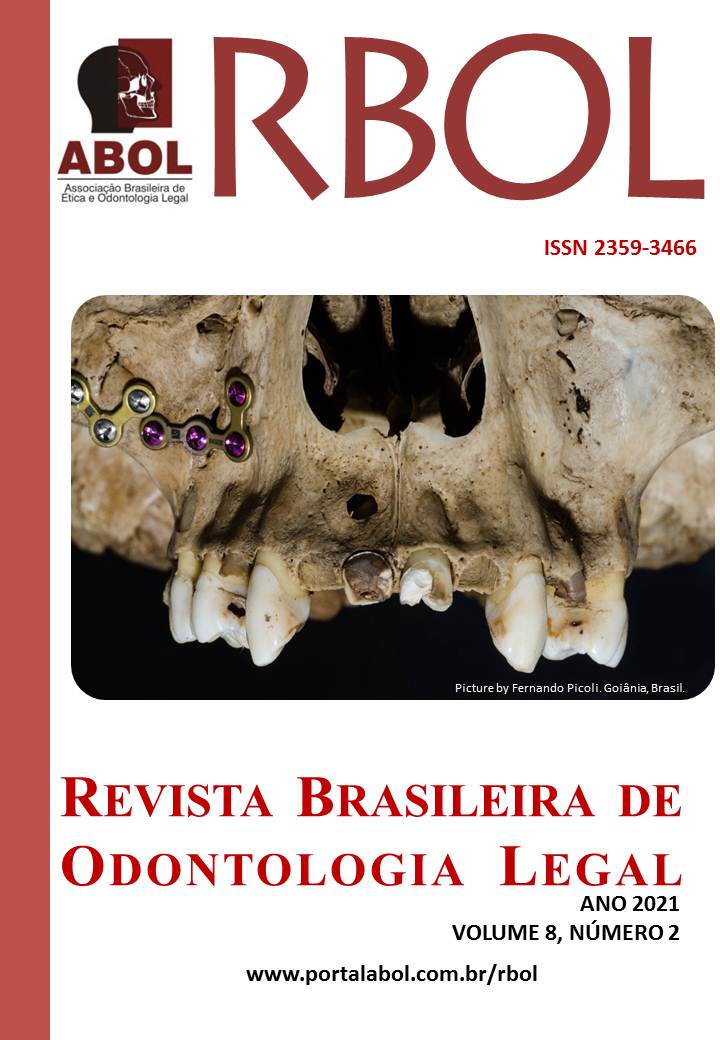LESÕES OROFACIAIS EM MULHERES VÍTIMAS DE VIOLÊNCIA NÃO FATAL: UMA REVISÃO INTEGRATIVA.
DOI:
https://doi.org/10.21117/rbol-v8n22021-355Keywords:
Violence Against Women, Gender-Based Violence, Facial Injuries, Tooth Injuries, Forensic DentistryAbstract
Introduction: A large proportion of violent acts against women result in maxillofacial injuries. The facial region is the most recurrent site of physical violence, because the abuser wishes to highlight the victim's frailty and distance it socially, causing psychological, aesthetic and moral damage. Objective: To analyze the craniofacial regions most affected and the profile of women who have suffered non-fatal violence, with expertise carried out in the services of legal medicine or registered in the police stations' police reports. Method: This is an integrative literature review, with identification of articles in SciELO, MEDLINE/ PubMed, LILACS and BBO, using the keywords "domestic violence", "facial injury", "facial trauma" and its variants in languages English and Portuguese. Results: 14 studies were selected. The women's ages ranged from 16 to 64 years, with the majority having domestic occupations and financial dependence on their spouse or partner. The face was the body site most affected by injuries, as it is a vulnerable region. Most injuries are bruises from the use of a blunt instrument or physical force. Other injuries, such as dental fractures, tooth avulsion, facial fractures and edema, were also found. Conclusion: The upper third of the face was the most affected, especially the orbit, and the most common type of injury was bruises usually caused by partners. Early identification of injuries can help prevent femicide, as the victim can be guided on how to proceed.
Downloads
Published
Issue
Section
License
Os autores deverão encaminhar por email, devidamente assinada pelos autores ou pelo autor responsável pelo trabalho, a declaração de responsabilidade e transferência de direitos autorais para a RBOL, conforme modelo abaixo.
DECLARAÇÃO DE RESPONSABILIDADE E TRANSFERÊNCIA DE DIREITOS AUTORAIS
Eu (Nós), listar os nomes completos dos autores, transfiro(rimos) todos os direitos autorais do artigo intitulado: colocar o título à Revista Brasileira de Odontologia Legal - RBOL.
Declaro(amos) que o trabalho mencionado é original, não é resultante de plágio, que não foi publicado e não está sendo considerado para publicação em outra revista, quer seja no formato impresso ou no eletrônico.
Declaro(amos) que o presente trabalho não apresenta conflitos de interesse pessoais, empresariais ou governamentais que poderiam comprometer a obtenção e divulgação dos resultados bem como a discussão e conclusão do estudo.
Declaro(amos) que o presente trabalho foi totalmente custeado por seus autores. Em caso de financiamento, identificar qual a empresa, governo ou agência financiadora.
Local, data, mês e ano.
Nome e assinatura do autor responsável (ou de todos os autores).

